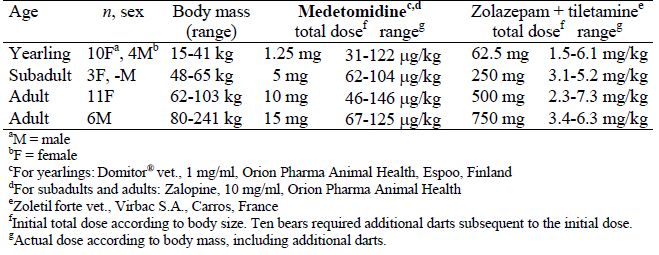Pulmonary Gas Exchange and Acid-Base Status During Medetomidine/Zolazepam/Tiletamine Anesthesia of Free-Ranging Brown Bears (Ursus arctos)
American Association of Zoo Veterinarians Conference 2007
Åsa Fahlman1,2, DVM, VetMedLic; Jon M. Arnemo3,4, DVM, PhD; Jon E. Swenson5, PhD; Sven Brunberg6; John Pringle2, DVM, PhD; Görel Nyman7, DVM, PhD, DECVA
1Department of Wildlife, Fish and Environment, National Veterinary Institute of Sweden, Uppsala, Sweden; 2Department of Clinical Sciences, Faculty of Veterinary Medicine and Animal Science, Swedish University of Agricultural Sciences, Uppsala, Sweden; 3Section of Arctic Veterinary Medicine, Department of Food Safety and Infection Biology, Norwegian School of Veterinary Science, Tromsø, Norway; 4Faculty of Forestry and Wildlife Management, Hedmark University College, Koppang, Norway; 5Department of Ecology and Natural Resource Management, Norwegian University of Life Sciences, As, Norway; 6Scandinavian Brown Bear Research Project, Tackåsen, Orsa, Sweden; 7Department of Companion Animals and Horses, National Veterinary Institute of Sweden, Uppsala, Sweden
Abstract
In Sweden and Norway, around 75 free-ranging brown bears (Ursus arctos) are anesthetized each year for ecological studies in the Scandinavian Brown Bear Research Project. The aim of this study was to evaluate pulmonary gas exchange and acid-base status during anesthesia of free-ranging brown bears. The bears were darted from a helicopter with medetomidine, zolazepam and tiletamine (MZT) using standard drug doses according to body size (Table 1). During anesthesia of 34 brown bears, 75 arterial blood samples were collected, and rectal temperature, heart rate, and respiratory rate were recorded. The blood samples were immediately processed for 15 different parameters with an i-STAT® Analyzer (CG4+, 6+, Abbott Laboratories, Abbott Park, IL, USA). For anesthetic reversal, atipamezole (Antisedan®, 5 mg/ml, Orion Pharma Animal Health, Espoo, Finland) was administered IM at 5 times the medetomidine dose.
Table 1. Age, sex, body mass and drug doses used in free-ranging brown bears in Sweden and Norway

Initial lactic acidemia (pH<7.35, lactate ≤11.8 mmol/L) as a result of physical exertion during induction improved during anesthesia. PaCO2 ranged between 29–54 mm Hg and PaO2 ranged between 49–103 mm Hg. Four bears developed hypoxemia (PaO2<60 mm Hg) but oxygen supplementation at 2 L/minute markedly improved oxygenation (PaO2 up to 290 mm Hg). Additional darts did not impair the physiologic parameters measured, indicating that the drug combination has a wide margin of safety in the species. In conclusion, mild to moderate alterations in arterial blood gases and acid-base balance were identified in anesthetized brown bears. Pulmonary function was adequate in most bears, but it is advisable to have supplemental oxygen available in case of hypoxemia.
Acknowledgments
Many thanks to the Swedish Environmental Protection Agency, the Norwegian Directorate for Nature Management, and the Michael Forsgren Foundation for generous support of this study. Also, thanks to Ulf Grinde, our helicopter pilot during fieldwork.